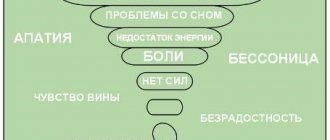As the World Health Organization points out, depression is one of the leading causes of morbidity and disability among adolescents and adults [WHO, 2020]. Back in 2021, more than 120 million people worldwide suffered from depression. According to official data, depression is diagnosed in only 40% of patients who actually suffer from it. It is also reported that we have entered an age of melancholy [G. Lyubin, 2019]. We are convinced that after 2021, when we had to endure an epidemic, quarantine, transition to distance learning and work, the situation with this unpleasant disease has not improved...
Unfortunately, the word “depression” can be heard or seen almost everywhere today, sometimes even in places where it is completely inapplicable, and from people who actually do not understand what it is and do not take it seriously. You need to understand that any melancholic mood, decline in emotional tone, apathy or lethargy cannot be recognized as depression, these are only its symptoms. The disease itself is much more complex, extensive and complex. Let's figure out together what it is and whether depression can be measured somehow.
Depression: briefly about the concept
The classic definition of depression includes three components:
- Anhedonia is a decrease in the ability to receive pleasure from factors that once brought it.
- Cognitive impairments specific to depression: decreased rate of thinking, presence of pessimistic judgments in thinking, etc.
- Decreased motor activity: movements become reluctant, slow, heavy.
Biochemically, depression is usually defined by a lack of mainly two hormones - serotonin and norepinephrine. That is why most drugs containing these neurotransmitters, so-called antidepressants, are designed to help fight depression.
Depression usually comes in two forms:
- astheno-depressive syndrome (apathetic or melancholy depression);
- anxiety-depressive syndrome (anxious depression).
In terms of content, these two forms differ in the emotional state in which a person is: in the first form, apathy, deterioration in motor and cognitive activity, and a melancholic mood are observed; with the second, a person is overcome by anxiety, phobias, anger, etc. Depending on the specific form, psychotherapists select the necessary course of treatment [G. Lyubin, 2019].
There are two main ways to combat depression: taking antidepressants and psychotherapy sessions. In this case, a person must be determined to heal, he must necessarily have a desire. If this is not the case, then friends and relatives should be active, try to help the patient, try to cheer him up and push him on the path of competent treatment.
If you want to know a little more about what depression will bring in the future, we recommend watching the following video from the PostScience project:
If you feel that some of the symptoms of depression are becoming your life companions, then we advise you to take action in time. One of these methods is our online program “Mental Self-Regulation”, where in 6 weeks you can overcome stress, get rid of anxiety and fear, apathy, procrastination and other unwanted symptoms that can lead to depression.
And we smoothly move on to the method of assessing the disease in question, and we will begin with the introduction of a major scientist of our time, whose name is directly related to the depression scale.
Decoding the results obtained
Each of the questions listed above is accompanied by four main versions of statements, arranged in a strictly defined order. Each of them has its own number of points, and if the first option is given a zero, and the second one – one, then the third and fourth, respectively, are awarded two and three points. After answering all the questions, the total number of points scored is summed up, according to which the result is assessed.
You can take this test completely free of charge using any online resource. As a rule, scoring during online testing is carried out automatically, after which the finished result and its detailed interpretation are issued, which, if desired, can be downloaded and shown to your doctor or any other specialist.
When taking the test, you must remember that there are two options for deciphering it, the first of which is relevant for adults, and the second for adolescent test takers, since the perception of life among representatives of these two groups has a number of significant differences. Thus, for persons who have reached full adulthood, the following interpretation of the completed depression test on the Aaron Beck scale is considered relevant:
- From 0 to 9 points. A result falling within this interval is considered an absolute norm, indicating that the person is not currently susceptible to depressive syndrome.
- From 10 to 15 points. This interval indicates the presence of so-called subdepression, which is characterized by the mildest symptoms of this condition.
- From 16 to 19 points. An average indicator indicating the presence of moderate depression, which may be due to seasonal manifestations or some situational issues.
- From 20 to 29 points. An indicator falling within this range is considered a sure sign of depression of moderate severity, which is often pronounced.
- From 30 to 63 points. Despite the large step, any score above 30 points indicates that the test taker is suffering from severe depression, which requires work with a specialist.
The results obtained when people undergoing the test during puberty have a slightly different interpretation, although in this case more stringent evaluation criteria are applied. Thus, the norm is considered to be a range from 0 to 9 with a moderate indicator of psychological state up to 4 points. A result falling in the range from 10 to 19 points indicates mild depression. If a teenager scores up to 22 points, then he may be diagnosed with moderate depression. Anything above 24 points is a sign of severe depression.
In the latter case, it is strongly recommended to resort to therapeutic correction of the test person’s condition, and it is possible that the therapy will be based on taking special medications - antidepressants. Typically, a comprehensive correction is carried out until the total score based on the results of repeated testing falls below ten and a stable positive trend is observed in the patient’s general condition.
Meet Aaron Beck
Born into a family of Jewish immigrants from the Russian Empire, Aaron Temkin-Beck initially studied psychoanalysis, but became disillusioned with this direction and decided to devote his life to the study of depression. It must be admitted that this was by no means a wrong decision.
Beck created his own model of depression, and also became the founder of cognitive therapy, a new method for his time in the treatment of affective disorders (depressive, bipolar and manic spectrum). His hostility to psychoanalysis is also explained by the disgusting methods used in the practice of treating neurosis: the scientist refuses the unconscious method - he is interested in finding conscious causes. It is no coincidence that in his monograph “Cognitive Therapy and the Emotional Disorders” (Cognitive Therapy and the Emotional Disorders, 1976) he talks about [A. Alexandrov, 1997].
In 1994, Aaron Beck and his daughter Judith co-founded the Beck Institute for Cognitive Therapy and Research, a nonprofit organization in Philadelphia. Its mission is to train professional cognitive therapy techniques for healthcare professionals and the mental health sector in particular, as well as to disseminate the latest methods of psychotherapy throughout the world.
Aaron Beck is Professor Emeritus in the Department of Psychiatry at the University of Pennsylvania. His theory is used in many studies, as well as in the direct treatment of clinical depression. The main areas of research of the scientist are psychotherapy, psychopathology, psychology of suicidal tendencies, and psychometrics. He published more than 600 scientific articles and became the author and co-author of 25 books. In 1989, Beck was recognized by The American Psychologist as one of the five most influential psychotherapists of all time. By the way, Martin Seligman, the founder of the theory of learned helplessness, was largely inspired by the works of Aaron Beck [Goodreads, 2015].
However, the psychologist received the greatest recognition for creating his own model for assessing depression - the so-called Beck Depression Inventory (BDI). This is what will be discussed below.
Measuring the level of depression
In 1961, Aaron Beck, along with other authors, proposed his own method for assessing depression in an individual. The test was based on the most relevant and significant symptoms and manifestations of depression, identified during numerous clinical observations and the most frequently reported complaints from patients. The original version of the scale was subject to adjustments, so in some sources you can find an amended abbreviation - BDI-II. In general, the scale has been actively used since its creation in the presence of clinical signs of depressive syndrome.
The scale is constructed in the form of a questionnaire test consisting of 21 questions with answer options. In each of the statements offered as options, one can find signs of both a person suffering from depression and a person belonging to the healthy group. In this case, each statement is assigned a score (from 0 to 3) depending on the severity of the depressive disorder (accordingly, zero is the absence of depression, three is the highest level of the symptom). In conclusion, the patient is assigned a score from 0 to 63, expressing the degree of presence of depressive syndrome [J Butcher, 1998].
There is also a short version of the Beck Depression Inventory, consisting of 13 questions, which no less adequately assesses the level of depressive moods in an individual, but the original version is the most complete and reliable option.
Among the signs noted in the Beck Depression Inventory are the following: depressed mood, low self-esteem, social isolation, and sleep problems. It is no coincidence that this test is also called the Anxiety and Depression Scale, because It is obvious that all of the above symptoms directly lead to anxious thoughts that haunt us and lead to an unpleasant disorder [V. Lyusov, 2010]
Initially, the test was administered by an examiner who read the questions aloud, and the patient could follow the questions from a copy of the questionnaire given to him. In addition, the expert (this could be a clinical psychologist, social worker, psychiatrist, etc.) took into account the characteristics of the respondent’s previous experience (historical characteristics), his intellectual development and other parameters of interest. Today, every person with access to Internet resources can take the depression scale on their own without any problems.
Beck test
We invite you to take the Beck Depression Scale online right now, conditionally dividing the entire test into two parts: the first 13 questions will concern cognitive-affective personality traits associated with intellectual and emotional activity, and the remaining 8 questions will be associated with somatic signs of depression associated with physical , human bodily movements. Take the test, then track your results and don't forget to share them in the comments.
(1) Do you feel upset or sad?
- I don't feel sad
- Yes, I periodically experience frustration and sadness
- I'm constantly upset, I can't get rid of this condition
- I'm so upset that I can't stand it lately
(2) What are your expectations for your future?
- I don't have any anxious thoughts about the future
- I'm confused about my future
- I have no positive expectations for the future
- I guess my future is hopeless and it won't bring me anything good
(3) Would you describe yourself as a loser?
- I can't call myself a failure
- I tend to make more mistakes than others
- Looking back I see a lot of failures
- I feel like a complete failure
(4) Are you satisfied with your life?
- I get as much satisfaction as I did before
- I get less satisfaction from life now than before
- Almost nothing brings me satisfaction
- I'm deprived of all satisfaction, I'm tired of everything
(5) Do you feel guilty?
- I have no reason to feel guilty/guilty
- I feel guilty quite often
- Most of the time I blame myself for something
- The feeling of guilt never leaves me
(6) Do you deserve to be punished?
- No, there's nothing to punish me for
- To some extent yes
- I'm waiting for punishment because I deserve it
- I've already been punished
(7) Would you say that you are disappointed in yourself?
- No, I treat myself as always
- Perhaps, in some moments - yes
- Yes, I'm disappointed in myself
- I feel disgusted with myself
(8) How critical are you of your personality?
- I'm no worse than others
- There are some aspects within me that deserve criticism
- I am critical of all my mistakes
- I criticize myself for everything bad that happens
(9) Do you have thoughts of suicide?
- No never
- Sometimes I think about suicide, but I know that I will never take this step
- Yes, I have a desire to commit suicide
- I would definitely do this if given the opportunity
(10) Can we say that you began to cry more often?
- I'm not crying more than usual
- I cry more often now compared to the past
- I cry almost every time because of every little thing.
- Even when I want to cry, I can't
(11) Have you become more irritable?
- I get excited no more often than before
- I'm easier to piss off now than before
- I feel irritated almost constantly
- Lost interest in things that previously irritated me; now I don't care
(12) Are you interested in other people?
- Yes, I'm interested in other people
- Less now than it was in the past
- I'm almost not interested in people
- There are few things in life that interest me
(13) Do you find it difficult to make decisions?
- I put off making decisions as often as before
- It's harder for me to make decisions now
- I have serious difficulty making decisions
- I hardly make decisions
(14) How do you rate your appearance?
- I look the same as always
- Now I look worse than before
- I have become unattractive, I look much worse compared to before
- I look awful
(15) Do you have difficulty doing any work?
- No, I work as energetically as before
- No, but I need to make an extra effort when I start work
- Yes, it's hard for me to do anything
- I don't have the energy to do any work
(16) Do you have trouble sleeping?
- No. I sleep as usual
- Minor. I sleep a little worse than before
- I sleep an hour or two less than before
- Yes. I have serious problems sleeping
(17) Can we say that you get tired more often?
- I'm no more tired than before
- Now I get tired faster than before
- I feel tired from almost any activity
- I feel tired all the time, so I can't do anything.
(18) How do you feel about food?
- My appetite hasn't changed lately
- I used to have a healthier appetite
- I have problems with appetite
- I almost never feel hungry
(19) Have you noticed changes in your weight?
- I haven't had any significant changes in weight recently
- Recently I have lost more than 2 kg
- I have recently lost more than 5 kg
- Recently I have lost more than 7 kg
(20) Are you worried about your health?
- No. I feel the same way as before
- I'm worried about some health problems
- I am concerned about my health and think about it often
- I constantly think about how bad my health is
(21) Have you noticed changes in your sexual desire?
- My interest in sex has not changed lately
- I think less about sex now than before
- I have practically lost interest in sexual problems
- I don't think at all about sex and the problems associated with it
Test results:
- 0-9 – absence of depressive disorder.
- 10-15 – mild depression (subdepression).
- 16-19 – medium-level depression (moderate).
- 20-29 – severe depression.
- 30-63 – severe depression.
We hope that your result was satisfactory and that depression has not entered your life in any way. If the final scores turned out to be high, we advise you to refer to the materials in the article “Everything is bad! What should I do?” and don’t forget about the effective techniques proposed in our online program.
Now, having familiarized ourselves with the test, we can determine what the portrait of a person suffering from depression is.
First aid for severe depression
Before the doctor arrives, you can take some measures to help the patient:
- Call a doctor or an ambulance.
- Keep the sick person in your sight. You need to know what he is doing now.
- If he asks to talk to him, don't refuse him. In conversation, do not be intrusive, try to show participation in his experiences. Sympathy can bring relief from mental suffering.
- Remember that severe depression is dangerous for suicide, so, “just in case,” protect the patient from sharp objects and do not leave him alone with open windows at a height.
- Limit the number and severity of external stimuli (move noisy children out of sight, turn off bright lights, remove loud music, etc.).
Treatment of severe depression is not fundamentally different from the treatment of ordinary depression, except that preference is given to intensive treatment methods: active pharmacotherapy, intensive psychotherapy, physical therapy, biofeedback therapy, etc.
Depression by Aaron Beck
So, all the answers that are on the last line of the proposed answers for each of the questions “weigh” three maximum points, respectively, they together constitute the most severe form of depression.
It turns out that depression is a disorder in which a person cannot receive joy from factors that once brought him joy. Such a person does not see pleasure, does not strive for it, his image is full of melancholy, sadness, sad thoughts about his present. But in fact, not only the present.
It is no coincidence that the questionnaire contains questions about the status of a loser/failure. Let's add another question about feelings of guilt and we get that a person suffering from depression tends to blame himself for some events from the past; he believes that he made many mistakes that led to terrible consequences. This is where a critical attitude towards oneself comes from.
The dominance of sadness, apathy, manifested in the inability to even cry, or even get irritated, lack of interest in the lives of other people, in fact, loss of the meaning of existence and the desire to end it - these are direct symptoms of a severe form of depressive disorder.
Of course, when answering a question about the future, such a person cannot be optimistic, and he is inclined to see only sad, rainy, pessimistic prospects for his life. It turns out that literally the entire life of a person seriously ill with depression is painted in gray and black tones. All described characteristics are associated with the cognitive-affective characteristics of the syndrome.
As for the somatic features of the course of depression, based on the Beck Depression Scale, they include:
- increased fatigue;
- energy deficiency;
- sleep problems;
- lack of appetite and weight loss;
- loss of sexual desire;
- overall deterioration of health.
As you can see, this is not the best image of a person. Undoubtedly, depressive disorder, especially in severe forms, is a serious problem that requires the intervention of specialists. Therefore, if you feel that you are gradually sinking into a depressive state, that you are experiencing more and more of the symptoms indicated above, immediately contact a psychologist.
However, some experts question the uniformity and reliability of the Beck Depression Inventory. Let's see what criticism this method of identifying depressive disorder is exposed to.
Service price
- HOSPITAL Day hospital5 000
- Day hospital with intensive care8,000
- 24-hour hospital (all inclusive, cost per day) 12,000
- 24-hour hospital (all inclusive, cost per day). Single occupancy24,000
- 24-hour hospital (all inclusive, cost per day). Single occupancy in a superior room 36,000
- Primary family counseling for relatives of patients undergoing inpatient treatment free of charge
- Group psychotherapy for relatives of patients undergoing inpatient treatment free of charge
- Group psychotherapy for 24-hour and day hospital patients free of charge
- Individual post for a hospital patient (if indicated)6,000
Depression
is one of the most common mental disorders. For most people, depression is mild. From 5 to 10% of all depressive conditions reach moderate and severe severity. Such cases are called severe depression.
Criticism of A. Beck's scale
Scientists at the Department of Psychiatry at the University of Heidelberg in Germany, analyzing the Beck Depression Inventory, came to several critical conclusions. In particular, P. Richter and his colleagues point out the insufficient number of characteristics taken into account as symptoms of depressive disorder, and also question the objectivity of the test results due to the variability of the scores over time (even taking into account one day). At the same time, the advantages associated with the internal consistency of the factors, a clear distinction between symptoms in people with depression and healthy people, and international applicability are also indicated [P. Richter, 1998].
Another scientific work carried out by the team of the Rostov State Medical University (hereinafter referred to as Rostov State Medical University) raises the possibility and reliability of using such a method as a scoring scale in identifying suicidal symptoms. The authors, conducting an experiment on randomly selected 312 students of Rostov State Medical University:
- assessed the risk of suicidal behavior using a projective technique (test “Suicidal tendencies by Z. Koroleva);
- assessed the risk of suicidal behavior using a questionnaire (Beck Depression Inventory, called the “Hopelessness Scale” by the authors);
- compared the results obtained in order to determine the verification of the competence of both methods.
The results turned out to be disappointing, because... content presented diametrically different conclusions. The scientists summarized the issue of the validity and reliability of the techniques used, and also insisted on the need to preserve the clinical method. The authors also call for looking for additional, more guaranteed means of identifying suicidal tendencies [V. Soldatkin, 2015].
Despite these comments, the Beck Depression Scale is a fairly common instrument for various studies, primarily psychological. Let's highlight some of them.
Procedure
Instructions
“This questionnaire contains groups of statements. Read each group of statements carefully. Then identify one statement in each group that best matches how you felt THIS WEEK AND TODAY. Check the box next to the statement you selected. If several statements from one group seem equally good to you, then check the box next to each of them. Make sure you read all statements in each group before making your choice."
Application of the Beck Depression Inventory
On some platforms you can find quite a lot of material devoted to research in the field of psychology, where, when it is necessary to assess the level of depression, none other than the Beck Anxiety and Depression Inventory is used. Let us cite some of these scientific works.
Food addiction [A. Guslistova, E. Guskova, 2020]
Or, in other words, food addiction. As part of the study, 15 patients who underwent longitudinal gastrectomy due to obesity were interviewed - 11 women and 4 men aged 35-65 years. The objectives of the study were to assess food addiction after surgery, assess the presence and level of depression, and identify the mathematical relationship between these two disorders. Various questionnaires were selected as tools, in particular the Dutch Eating Behavior Questionnaire, the Yale Food Addiction Scale, and the familiar Beck Depression Inventory.
The results of the survey on the Beck scale indicated a value of 14.33 (with an error of 1.554 points), which was a sign of mild depression. The results of surveys on other scales and an assessment of their relationship with the depression scale led to the conclusion that patients suffering from food addiction and undergoing surgery need to undergo complex therapy, including psychological therapy along with surgical therapy.
Another study involved the analysis of photos posted on the social network Instagram.
Color schemes of photos on the social network [Yu. Emelyanova, M. Khachumov, 2020]
In order to identify emerging personality disorders, so-called predictors of depression, the paper proposes to evaluate the color scheme of photographs posted on a social network. The method of detecting depression using graphic content is gaining popularity, and, according to many other works, it is the color characteristic that is most indicative.
The study analyzed 45,848 photographs of 673 respondents who completed the Beck Questionnaire. Based on the results of the work, the authors came to the conclusion that assessing depression solely based on graphic content cannot serve as a full-fledged replacement for classical methods for identifying depression due to the insufficient connection between the two characteristics under consideration (color ranges and level of depression).
Thus, the Beck scale once again became a tool for forming a conclusion about the correlation between two psychological phenomena. Of course, there is no single unique tool for identifying depressive symptoms, but taking the Beck Depression Scale will be useful not only for participants in a psychological experiment, but also for ordinary people trying to deal with bad mood, apathy and other undesirable phenomena.
We wish you a great mood and ask you to answer the question on the topic of the article:
We also recommend reading:
- Storytelling
- Bipolar disorder: definition, causes, episodes, treatment
- Postpartum depression: symptoms, scale, how long it lasts and how to get out of it
- A Guide to Relieving Depression and Apathy
- Pros and cons of melancholy
- Munchausen syndrome
- Everything is bad! What to do?
- Endogenous depression: signs, symptoms and treatment
- Post-traumatic stress disorder: briefly about the most important things
- How to help your child cope with depression
- Overcoming spiritual depression
Key words:1Psychoregulation











